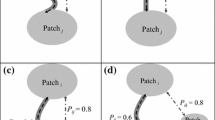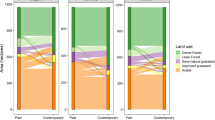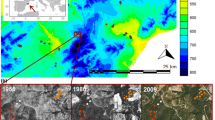Abstract
Extensive afforestation of agricultural areas has increased the importance of green corridors as a dispersal network. We tested the effect of spatiotemporal connectivity, edge effect and habitat structural quality of wooded corridors on the long-term immigration success of forest specialist plants relative to the performance of forest generalists. In agricultural landscapes of central and southern Estonia, we sampled 28 historically connected and 52 isolated tree lines and alleys with a minimum age of 50 years, and 93 edges of ancient forests. The regional pool of common forest plants was compiled using species’ frequency data in 91 ancient forests. Both landscape connectivity and habitat quality affected the richness of response groups, but specialists and generalists responded to different drivers. Forest specialists required long-term neighbourhoods of ancient forest and benefited from a direct connection between forest and corridor. Habitat generalists reacted positively to the recently modified structure of the landscape. When a corridor was connected to forest, the dual edge in the corridor did not result in an increased negative edge effect on forest specialist arrival. Even if both specialists and generalists required wide corridors with optimum shade, forest specialists also benefited from mature overstorey and outward overhanging branches, whereas forest generalists used disturbance-created microhabitats. We conclude that only wooded corridors with long-term connectivity to seed source forests and widely branched tree canopies will function as a green infrastructure supporting forest-specific biodiversity.





Similar content being viewed by others
References
Aunap R (2011) Eesti Atlas, 4th edn. Avita, Tallinn
Baeten L, Jacquemyn H, Van Calster H et al (2009) Low recruitment across life stages partly accounts for the slow colonization of forest herbs. J Ecol 97:109–117. doi:10.1111/j.1365-2745.2008.01455.x
Bailey S (2007) Increasing connectivity in fragmented landscapes: an investigation of evidence for biodiversity gain in woodlands. For Ecol Manag 238:7–23. doi:10.1016/j.foreco.2006.09.049
Beier P, Noss RF (1998) Do habitat corridors provide connectivity? Conserv Biol 12:1241–1252. doi:10.1111/j.1523-1739.1998.98036.x
Bolger DT, Scott TA, Rotenberry JT (2001) Use of corridor-like landscape structures by bird and small mammal species. Biol Conserv 102:213–224. doi:10.1016/S0006-3207(01)00028-3
Bossuyt B, Hermy M (2001) Influence of land use history on seed banks in European temperate forest ecosystems: a review. Ecography 24:225–238. doi:10.1034/j.1600-0587.2001.240213.x
Bossuyt B, Hermy M, Deckers J (1999) Migration of herbaceous plant species across ancient–recent forest ecotones in central Belgium. J Ecol 87:629–638. doi:10.1046/j.1365-2745.1999.00379.x
Brudvig LA, Mabry CM, Mottl LM (2011) Dispersal, not understory light competition, limits restoration of Iowa woodland understory herbs. Restor Ecol 19:24–31. doi:10.1111/j.1526-100X.2010.00675.x
Brunet J, von Oheimb G (1998) Migration of vascular plants to secondary woodlands in southern Sweden. J Ecol 86:318–327. doi:10.1016/S0378-1127(96)03845-5
Brunet J, Falkengren-Grerup U, Tyler G (1996) Herb layer vegetation of south Swedish beech and oak forests—effects of management and soil acidity during one decade. For Ecol Manag 88:259–272. doi:10.1046/j.1365-2745.1998.00269.x
Brunet J, von Oheimb G, Diekmann M (2000) Factors influencing vegetation gradients across ancient–recent woodland borderlines in southern Sweden. J Veg Sci 11:515–524. doi:10.2307/3246581
Butaye J, Jacquemyn H, Hermy M (2001) Differential colonization causing non-random forest plant community structure in a fragmented agricultural landscape. Ecography 24:369–380. doi:10.1111/j.1600-0587.2001.tb00472.x
Corbit M, Marks PL, Gardescu S (1999) Hedgerows as habitat corridors for forest herbs in central New York, USA. J Ecol 87:220–232. doi:10.1046/j.1365-2745.1999.00339.x
de Blois S, Domon G, Bouchard A (2002) Landscape issues in plant ecology. Ecography 25:244–256. doi:10.1034/j.1600-0587.2002.250212.x
Deckers B, Hermy M, Muys B (2004) Factors affecting plant species composition of hedgerows: relative importance and hierarchy. Acta Oecol 26:23–37. doi:10.1016/j.actao.2004.03.002
Dennis RLH, Dapporto L, Dover JW, Shreeve TG (2013) Corridors and barriers in biodiversity conservation: a novel resource-based habitat perspective for butterflies. Biodivers Conserv 22:2709–2734. doi:10.1007/s10531-013-0540-2
Didham RK, Lawton JH (1999) Edge Structure determines the magnitude of changes in microclimate and vegetation structure in tropical forest fragments. Biotropica 31:17–30. doi:10.1111/j.1744-7429.1999.tb00113.x
Dormann CF, McPherson JM, Araújo MB et al (2007) Methods to account for spatial autocorrelation in the analysis of species distributional data: a review. Ecography 30:609–628. doi:10.1111/j.2007.0906-7590.05171.x
Dupré C, Ehrlén J (2002) Habitat configuration, species traits and plant distributions. J Ecol 90:796–805. doi:10.1046/j.1365-2745.2002.00717.x
Fahey RT, Puettmann KJ (2008) Patterns in spatial extent of gap influence on understory plant communities. For Ecol Manag 255:2801–2810. doi:10.1016/j.foreco.2008.01.053
Forman RTT (1995) Some general principles of landscape and regional ecology. Landsc Ecol 10:133–142. doi:10.1007/BF00133027
Forman RT, Baudry J (1984) Hedgerows and hedgerow networks in landscape ecology. Environ Manag 8:495–510. doi:10.1007/BF01871575
Fox J, Weisberg S (2011) An R companion to applied regression, 2nd edn. Sage, Thousand Oaks
Fraver S (1994) Vegetation responses along edge-to-interior gradients in the mixed hardwood forests of the Roanoke River Basin, North Carolina. Conserv Biol 8:822–832. doi:10.1046/j.1523-1739.1994.08030822.x
Hamberg L, Lehvävirta S, Kotze DJ (2009) Forest edge structure as a shaping factor of understorey vegetation in urban forests in Finland. For Ecol Manag 257:712–722. doi:10.1016/j.foreco.2008.10.003
Herault B, Honnay O (2005) The relative importance of local, regional and historical factors determining the distribution of plants in fragmented riverine forests: an emergent group approach. J Biogeogr 32:2069–2081. doi:10.1111/j.1365-2699.2005.01351.x
Hermy M, Honnay O, Firbank L et al (1999) An ecological comparison between ancient and other forest plant species of Europe, and the implications for forest conservation. Biol Conserv 91:9–22. doi:10.1016/S0006-3207(99)00045-2
Hernández Á, Zaldívar P (2013) Epizoochory in a hedgerow habitat: seasonal variation and selective diaspore adhesion. Ecol Res 28:283–295. doi:10.1007/s11284-012-1014-9
Hess GR, Fischer RA (2001) Communicating clearly about conservation corridors. Landsc Urban Plan 55:195–208. doi:10.1016/S0169-2046(01)00155-4
Hobbs RJ (1992) The role of corridors in conservation: solution or bandwagon? Trends Ecol Evol 7:389–392. doi:10.1016/0169-5347(92)90010-9
Honnay O, Verheyen K, Hermy M (2002) Permeability of ancient forest edges for weedy plant species invasion. For Ecol Manag 161:109–122. doi:10.1016/S0378-1127(01)00490-X
Honnay O, Jacquemyn H, Bossuyt B, Hermy M (2005) Forest fragmentation effects on patch occupancy and population viability of herbaceous plant species. New Phytol 166:723–736. doi:10.1111/j.1469-8137.2005.01352.x
Humphrey JW, Watts K, Fuentes-Montemayor E et al (2015) What can studies of woodland fragmentation and creation tell us about ecological networks? A literature review and synthesis. Landsc Ecol 30:21–50. doi:10.1007/s10980-014-0107-y
Jacquemyn H, Butaye J, Hermy M (2001) Forest plant species richness in small, fragmented mixed deciduous forest patches: the role of area, time and dispersal limitation. J Biogeogr 28:801–812. doi:10.1046/j.1365-2699.2001.00590.x
Jacquemyn H, Butaye J, Hermy M (2003) Influence of environmental and spatial variables on regional distribution of forest plant species in a fragmented and changing landscape. Ecography 26:768–776. doi:10.1111/j.0906-7590.2003.03620.x
Kolb A, Diekmann M (2005) Effects of life-history traits on responses of plant species to forest fragmentation. Conserv Biol 19:929–938. doi:10.1111/j.1523-1739.2005.00065.x
Leht M (2010) Eesti Taimede Määraja, 3rd edn. Eesti Loodusfoto, Tartu
Liira J, Paal T (2013) Do forest-dwelling plant species disperse along landscape corridors? Plant Ecol 214:455–470. doi:10.1007/s11258-013-0182-1
Liira J, Lõhmus K, Tuisk E (2012) Old manor parks as potential habitats for forest flora in agricultural landscapes of Estonia. Biol Conserv 146:144–154. doi:10.1016/j.biocon.2011.11.034
Liira J, Jürjendal I, Paal J (2014) Do forest plants conform to the theory of island biogeography: the case study of bog islands. Biodivers Conserv 23:1019–1039. doi:10.1007/s10531-014-0650-5
Lõhmus E (2004) Eesti metsakasvukohatüübid, 2nd edn. Eesti Loodusfoto, Tartu
Lõhmus K, Liira J (2013) Old rural parks support higher biodiversity than forest remnants. Basic Appl Ecol 14:165–173. doi:10.1016/j.baae.2012.12.009
Lõhmus K, Paal T, Liira J (2014) Long-term colonization ecology of forest-dwelling species in a fragmented rural landscape—dispersal versus establishment. Ecol Evol 4:3113–3126. doi:10.1002/ece3.1163
MacDonald MA (2003) The role of corridors in biodiversity conservation in production forest landscapes: a literature review. Tasforests 14:41–52
Matlack GR (1993) Microenvironment variation within and among forest edge sites in the eastern United States. Biol Conserv 66:185–194. doi:10.1016/0006-3207(93)90004-K
McElhinny C, Gibbons P, Brack C, Bauhus J (2005) Forest and woodland stand structural complexity: its definition and measurement. For Ecol Manag 218:1–24. doi:10.1016/j.foreco.2005.08.034
Meiners SJ, Pickett STA (1999) Changes in community and population responses across a forest-field gradient. Ecography 22:261–267. doi:10.1111/j.1600-0587.1999.tb00501.x
Metzger MJ, Bunce RGH, Jongman RHG et al (2005) A climatic stratification of the environment of Europe. Glob Ecol Biogeogr 14:549–563. doi:10.1111/j.1466-822X.2005.00190.x
Moran PAP (1950) Notes on continuous stochastic phenomena. Biometrika 37:17–23. doi:10.2307/2332142
Murcia C (1995) Edge effects in fragmented forests: implications for conservation. Trends Ecol Evol 10:58–62. doi:10.1016/S0169-5347(00)88977-6
Naaf T, Kolk J (2015) Colonization credit of post-agricultural forest patches in NE Germany remains 130–230 years after reforestation. Biol Conserv 182:155–163. doi:10.1016/j.biocon.2014.12.002
Nordén B, Dahlberg A, Brandrud TE et al (2014) Effects of ecological continuity on species richness and composition in forests and woodlands: a review. Ecoscience 21:34–45. doi:10.2980/21-1-3667
O’Hara RB, Kotze DJ (2010) Do not log-transform count data. Methods Ecol Evol 1:118–122. doi:10.1111/j.2041-210X.2010.00021.x
Oksanen J, Blanchet FG, Kindt R et al (2013) vegan: Community Ecology Package
Paradis E, Claude J, Strimmer K (2004) APE: analyses of phylogenetics and evolution in R language. Bioinformatics 20:289–290. doi:10.1093/bioinformatics/btg412
Peppler-Lisbach C, Beyer L, Menke N, Mentges A (2015) Disentangling the drivers of understorey species richness in eutrophic forest patches. J Veg Sci 26:464–479. doi:10.1111/jvs.12249
Petit S, Griffiths L, Smart SS et al (2004) Effects of area and isolation of woodland patches on herbaceous plant species richness across Great Britain. Landsc Ecol 19:463–471. doi:10.1023/B:LAND.0000036141.30359.53
QGIS Development Team (2015) QGIS Geographic Information System. Open Source Geospatial Foundation
R Core Team (2016) R: a language and environment for statistical computing. R Foundation for Statistical Computing, Vienna
Richardson JTE (2011) Eta squared and partial eta squared as measures of effect size in educational research. Educ Res Rev 6:135–147. doi:10.1016/j.edurev.2010.12.001
Roy V, de Blois S (2008) Evaluating hedgerow corridors for the conservation of native forest herb diversity. Biol Conserv 141:298–307. doi:10.1016/j.biocon.2007.10.003
Schmidt M, Kriebitzsch W-U, Ewald J (2011) Waldartenlisten der Farn- und Blütenpflanzen. Moose und Flechten Deutschlands, Bundesamt für Naturschutz, Bonn
Sitzia T (2007) Hedgerows as corridors for woodland plants: a test on the Po Plain, northern Italy. Plant Ecol 188:235–252. doi:10.1007/s11258-006-9159-7
Valdés A, Lenoir J, Gallet-Moron E et al (2015) The contribution of patch-scale conditions is greater than that of macroclimate in explaining local plant diversity in fragmented forests across Europe. Glob Ecol Biogeogr 24:1094–1105. doi:10.1111/geb.12345
van Dorp D, Opdam PFM (1987) Effects of patch size, isolation and regional abundance on forest bird communities. Landsc Ecol 1:59–73. doi:10.1007/BF02275266
Venables WN, Ripley BD (2002) Modern applied statistics with S, 4th edn. Springer, New York
Wehling S, Diekmann M (2008) Factors influencing the spatial distribution of forest plant species in hedgerows of North-western Germany. Biodivers Conserv 17:2799–2813. doi:10.1007/s10531-007-9294-z
Wehling S, Diekmann M (2009) Importance of hedgerows as habitat corridors for forest plants in agricultural landscapes. Biol Conserv 142:2522–2530. doi:10.1016/j.biocon.2009.05.023
Whigham DF (2004) Ecology of woodland herbs in temperate deciduous forests. Annu Rev Ecol Evol Syst 35:583–621
Wulf M, Kolk J (2014) Plant species richness of very small forests related to patch configuration, quality, heterogeneity and history. J Veg Sci 25:1267–1277. doi:10.1111/jvs.12172
Acknowledgements
This project was supported by the Estonian Science Agency (project no. 7878, IUT 20-31 and IUT 34-7), the ERA-Net BiodivERsA project smallFOREST and the European Union through the European Regional Development Fund (the Centre of Excellence Ecolchange). We are grateful to Robert Szava-Kovats for comments and language editing. We also thank Thomas Abeli and two anonymous reviewers for their helpful comments.
Author information
Authors and Affiliations
Corresponding author
Ethics declarations
Conflict of interest
The authors declare no conflict of interest.
Additional information
Communicated by Thomas Abeli.
Electronic supplementary material
Below is the link to the electronic supplementary material.
Rights and permissions
About this article
Cite this article
Paal, T., Kütt, L., Lõhmus, K. et al. Both spatiotemporal connectivity and habitat quality limit the immigration of forest plants into wooded corridors. Plant Ecol 218, 417–431 (2017). https://doi.org/10.1007/s11258-017-0700-7
Received:
Accepted:
Published:
Issue Date:
DOI: https://doi.org/10.1007/s11258-017-0700-7




